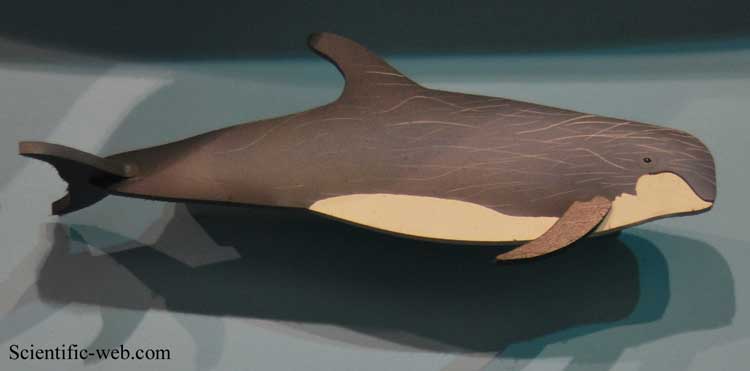Grampus griseus , Photo: Michael Lahanas Cladus: Eukaryota Name Grampus griseus (G. Cuvier, 1812) References * Grampus griseus on Mammal Species of the World. Vernacular names ------------ Risso's dolphin (Grampus griseus) is the only species of dolphin in the genus Grampus. Risso's dolphin is named after Antoine Risso, whose description formed the basis of the first public description of the animal, by Georges Cuvier, in 1812. Another common name for the Risso's dolphin is grampus (also the species' genus), although this common name was more often used for the orca. The etymology of the word grampus is unclear. It may be an agglomeration of the Latin grandis piscis or French grand poisson both meaning big fish. The specific epithet griseus refers to the mottled (almost scarred) grey colour of its body. Description Risso's have a relatively large anterior body and dorsal fin, while the posterior tapers to a relatively narrow tail. The bulbous head has a vertical crease in front.[3] Infants are dorsally gray to brown and ventrally cream-colored, with a white anchor-shaped area between the pectorals and around the mouth. In older calves, the non-white areas darken to nearly black, and then lighten (except for the always dark dorsal fin.) Linear scars mostly from social interaction eventually cover the bulk of the body. Older individuals appear mostly white. Most individuals have 2-7 pairs of teeth, all in the lower jaw.[3] Length is typically 10 feet (3.0 m) although specimens may reach 12.5 feet (3.8 m). Like most dolphins, males are typically slightly larger than females. This species weighs 300–500 kilograms (660–1,100 lb) making it the largest species called "dolphin".[4][5] Range and habitat It is found worldwide in temperate and tropical waters, usually in deep waters rather than close to land. As well as the tropical parts of the Indian, Pacific and Atlantic Oceans, Rissos are also found in the Persian Gulf, Mediterranean and Red Seas, but not the Black Sea. They range as far north as the Gulf of Alaska and southern Greenland and as far south as Tierra del Fuego.[3] Their preferred environment is just off the continental shelf on steep banks with water depths varying from 400–1,000 metres (1,300–3,300 ft) and water temperature at least 10 °C (50 °F) and preferably 15–20 °C (59–68 °F).[3] The population around the continental shelf of the United States is estimated in excess of 60,000. In the Pacific a census recorded 175,000 individuals in eastern tropical waters and 85,000 in the west. No global estimate exists. Ecology They feed almost exclusively on neritic and oceanic squid, mostly nocturnally. Predation does not appear significant. Mass strandings are infrequent.[3] These dolphins typically travel in groups of 10-50, but that may reach 400. Smaller, stable subgroups exist within larger groups. They also travel with other cetaceans. They harass and surf the bow waves of gray whales as well as ocean swells.[3] Reproduction Gestation requires an estimated 13-14 months, at intervals of 2.4 years. Calving reaches seasonal peaks in the winter in the eastern Pacific and in the summer and fall in the western Pacific. Females mature sexually at ages 8-10, and males at age 10-12. The oldest specimen reached 34.5 years.[3] Human interaction Risso's dolphins generally do not approach boats (they occasionally surf bow waves.)[3] A notable exception was an individual named Pelorus Jack who accompanied boats in Admiralty Bay in New Zealand's Marlborough Sounds for more than 20 years. Hunting of this species has never been particularly widespread, and the species is recognised as abundant and safe. However, operations off Sri Lanka may be significantly damaging the local population. They steal bait from longlines and get killed accidentally and deliberately by fishermen.[3] Risso's have successfully been taken into captivity in the United States and Japan, although not with the regularity of bottlenose dolphins or orca. Hybrid Risso's-bottlenose dolphins have been bred in captivity. Strandings At least one case report of strandings in Japan's Goto Islands has been associated with parasitic neuropathy of the VIIIth cranial nerve by a trematode in the genus Nasitrema.[6] References 1. ^ Mead, James G. and Robert L. Brownell, Jr (November 16, 2005). "Order Cetacea". in Wilson, D. E., and Reeder, D. M. eds. Mammal Species of the World (3rd ed.). Baltimore: Johns Hopkins University Press. pp. 723–743. ISBN 0-801-88221-4. http://www.bucknell.edu/msw3/browse.asp?id=14300098. * National Audubon Society Guide to Marine Mammals of the World ISBN 0-375-41141-0 Source: Wikispecies, Wikipedia: All text is available under the terms of the GNU Free Documentation License |
|


